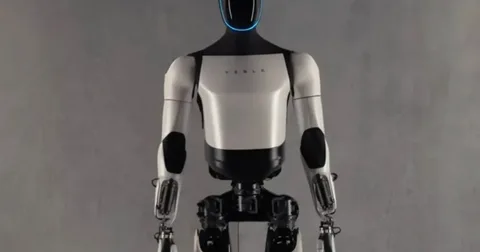The vision of humanoid robots walking alongside us, assisting in factories, homes, and disaster zones, has captivated the human imagination for decades. Today, that vision is rapidly becoming a commercial reality. But what transforms a conceptual animation or a lab prototype into a robust, functional machine capable of operating in the unpredictable real world?
The answer lies not just in sophisticated software and AI, but fundamentally, in the physical realm of precision engineering. The journey from a digital blueprint to a dynamic humanoid robot is bridged by advanced manufacturing capabilities, particularly 5 axis machining services, which are essential for producing the complex humanoid robot parts that give these machines their form and function.
The Manufacturing Challenge of Bipedal Machines
Humanoid robots represent one of the most demanding applications in modern manufacturing. Unlike stationary industrial arms, they require a unique combination of characteristics in their components:
- Lightweighting: Every gram counts for energy efficiency and dynamic movement. Parts must be strong yet incredibly light, often requiring complex internal geometries that are impossible to create with traditional machining.
- Complex Geometry: Components like hip joints, shoulder assemblies, and actuator housings feature compound curves and organic shapes that must interface perfectly in a 3D space.
- Uncompromising Strength and Durability: These parts must withstand constant stress, impact, and cyclic loading without failure.
- Extreme Precision: For smooth, accurate, and safe movement, bearing seats, gear meshes, and mounting surfaces must be machined to micron-level tolerances.
Attempting to produce these parts with 3-axis machining would require multiple, complex fixtures and numerous setups. Each setup introduces potential for human error, alignment inaccuracies, and significantly extended lead times. This is where a paradigm shift in manufacturing technology becomes not just beneficial, but essential.
5-Axis Machining: The Cornerstone of Robotic Anatomy
5 axis machining services provide the foundational capability to overcome these challenges. Unlike conventional 3-axis machines that move a tool in three linear directions (X, Y, Z), 5-axis machines can also rotate the tool and/or the workpiece on two additional axes (A and B).
This simultaneous movement is a game-changer for producing humanoid robot parts. Here’s why:
- Single-Setup Machining: A 5-axis machine can access virtually every surface of a complex part in a single clamping. This eliminates errors from multiple setups, ensures perfect feature alignment, and dramatically reduces production time. For a critical component like a robot femur or pelvis, this single-setup integrity is non-negotiable.
- Superior Surface Quality & Complex Geometries: The ability to maintain an optimal tool orientation to the workpiece allows for better cutting conditions. This results in superior surface finishes on complex contours, which is vital for reducing friction and wear in moving joints. It also enables the machining of those intricate, weight-saving organic shapes.
- Drilling and Tapping on Compound Angles: A robot’s skeleton is a network of parts connecting at complex angles. 5-axis machining allows for holes and threads to be drilled directly at these compound angles in a single, precise operation, a task that is highly inefficient and less accurate with 3-axis methods.
For a business developing robotics, partnering with an expert in 5 axis machining services like Falcon CNC Swiss is a strategic decision that accelerates development, reduces assembly issues, and enhances the final product’s performance and reliability.
A Partnership in Innovation: From Concept to Actuation
The relationship between a robotics company and its manufacturing partner must be deeply collaborative. It’s not merely about sending a CAD file and receiving a part. It’s about engineering feedback and material science.
For instance, at Falcon CNC Swiss, the process often involves a Design for Manufacturability (DFM) review. Their engineers work with client blueprints to suggest subtle modifications—like adding a slight draft to a wall or adjusting a corner radius—that make the part significantly stronger, easier to machine, or more cost-effective without compromising its function.
This collaborative approach is crucial for components like:
- Custom Actuator Housings: Requiring precise internal volumes and bearing seats for harmonic drives and sensors.
- Endoskeleton Structures: Machined from high-strength aluminum alloys or titanium to create a light yet rigid frame.
- Complex Joint Assemblies: Such as the knee or ankle, which integrate multiple points of rotation and load-bearing surfaces.
The expertise of a specialized manufacturer ensures that the materials selected—from aerospace aluminum to advanced engineering plastics—are perfectly suited to the application and machined to their full potential.
Driving Business Growth Through Technological Leadership
For a startup or an established company in the robotics space, this manufacturing partnership is a core competitive advantage. It enables:
- Faster Prototyping and Iteration: Rapid, accurate parts mean faster design cycles and a shorter time-to-market.
- Higher Product Reliability: Precision-machined components lead to more robust and dependable robots, building brand trust and reducing warranty claims.
- Scalability: A partner with the right technology and quality systems can scale from prototype volumes to full production seamlessly.
The journey of creating a humanoid robot is a monumental engineering challenge. It requires a synergy of brilliant software, innovative electrical systems, and, fundamentally, physical parts that can bring the digital dream to life. By leveraging top-tier 5 axis machining services and forming strategic partnerships with precision engineers, robotics companies are not just building machines; they are building the future.


